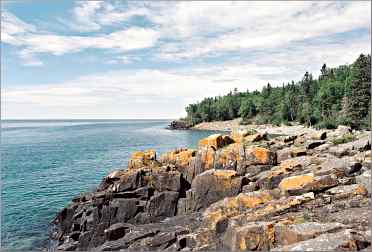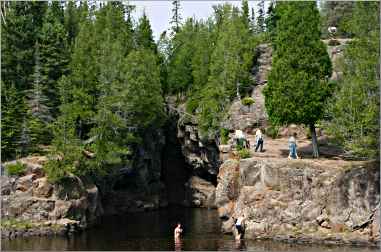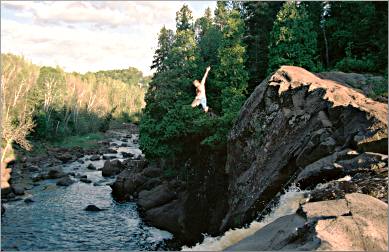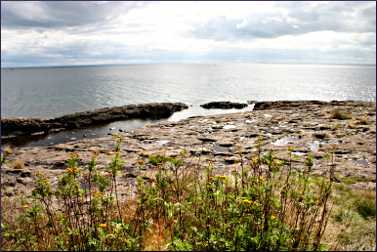Escape to Minnesota's North Shore
For stressed-out city folks, the shore of Lake Superior is hallowed ground.

© Beth Gauper
Ten thousand years ago, the melting of Minnesota's last glacier transformed a placid beach into a rugged coast.
It's a 150-mile stretch of wild beauty, lined by piles of jagged black basalt, cobblestone beaches and the mouths of dozens of rivers, tumbling down from the old beaches of Glacial Lake Duluth.
Seven state parks follow their winding gorges, marked by rapids and waterfalls, and the Superior Hiking Trail crosses them on its way from Duluth to the Canadian border.
This is Minnesota's breathing space, to which tourists return like spawning salmon, year after year, or whenever we need to fill our lungs with brisk Lake Superior air.
We can't really swim in the water — it's usually about 40 degrees, even in summer — but we can look at the views and walk through the forests, and we do.
The romance of crashing waves and wooded solitude makes the North Shore a favorite honeymoon and anniversary destination, but its popularity is universal.
Only a few decades ago, most visitors stayed in mom-and-pop resorts, usually a string of small cabins perched on the rocky shore. The traditional spots since have been joined — and often supplanted by — upscale condos and townhouses.
But the North Shore still is primarily for people who just want to be outdoors.
There's so much to see and do that planning a trip can be hard. It helps to know where the highlights are; for distances between state parks, attractions and towns.
For more, see North Shore by the mile.
The first stretch, on Old Highway 61 between Duluth and Two Harbors, retains the feel of the old shore and has several old-fashioned resorts.
In spring, fishermen flock to the French, Sucker and Knife rivers for smelt, salmon and trout. For more, see Minnesota's scenic 61.
The next stretch holds the densest concentration of scenery. Minnesota 61 passes through two tunnels cut through rock and over the waterfalls of Gooseberry Falls State Park, Minnesota's most-visited outstate park.

© Beth Gauper
Split Rock Lighthouse, just up the road, is the most-photographed spot on the shore and probably the state.
At Palisade Head, sheer pink cliffs rise from the lake, lining the shore to Shovel Point at Tettegouche State Park. For more, see The near North Shore.
The stretch between Schroeder and Lutsen attracts a well-heeled crowd to the cushy resorts and condos around Lutsen Mountains.
Many of the shore's most popular hiking trails are here, along the Temperance, Onion and Poplar rivers, as well as Eagle Mountain, the state's highest point. For more, see Hiking the North Shore.
Grand Marais was founded by fur traders, loggers and fishermen and still is the favorite spot of die-hard outdoors people, especially cross-country skiers. It's also the beginning of the Gunflint Trail and one of the gateways to the Boundary Waters Canoe Area Wilderness.
Hiking around here, especially around the Devil Track, Kadunce and Brule rivers, is the most dramatic of the shore. For more, see Four seasons of Grand Marais.
Few venture beyond Grand Marais, but those who do will be rewarded. Two centuries ago, Grand Portage was a fur-trading metropolis, and Grand Portage National Monument re-creates its colorful past in and around a reconstructed stockade.
Next door, ferries leave for Isle Royale National Park, one of the nation's best backpacking destinations. For more, see Life on the Grand Portage.
Six miles north, in Grand Portage State Park, the 120-foot High Falls of the Pigeon River cascade over a sheer basalt face. This is the unpassable chasm that forced the Ojibwe to make a 8½-mile grand detour, a route the voyageurs later adopted to reach the fur-rich interior.
The British-owned North West Company post moved across the border in 1803, and that era is re-created at Fort William Historical Park, where costumed interpreters work their magic in and around the continent's largest reconstructed post.
It's just one of the attractions of Thunder Bay, the largest city on Lake Superior and the most ethnically diverse. For more, see Exploring Thunder Bay.
According to Canadians, the real North Shore starts there; it is, of course, the north shore of Lake Superior.
But that's another story: For more, see Circling Superior.

© Beth Gauper
Trip Tips: Minnesota's North Shore
Driving distances: For a mile-by-mile guide to the landmarks of the North Shore, from Canal Park in Duluth at 0.0 to the Canadian border at 150.0, see North Shore by the mile.
It's 24 miles from Duluth to Two Harbors, then another 16 miles to Gooseberry Falls, 6 miles to Split Rock Lighthouse, 12 miles to Tettegouche State Park, 24 miles to Tofte and 7 miles to Lutsen.
From Lutsen, it's 10 miles to Cascade River State Park, 10 miles to Grand Marais, 14 miles to Judge C.R. Magney State Park/Naniboujou, 21 miles to Grand Portage National Monument and 6 miles to the Canadian border.
When to go: Peak season along the North Shore is summer, when people from all over the nation come to bask in the cool breezes of Lake Superior. Bring a jacket and pants even in July and August; nights can be cold, even around the traditional shore bonfire.
Fall weekends are even busier, when throngs come up to hike and see the hardwood forest burst into color. For more, see Colors of the North Shore.
Late October and early November is an excellent time to hike; muddy trails harden, falling leaves open up new vistas, the bugs are gone and hotel rates drop. Just remember to wear blaze-orange — deer firearm season starts the first Saturday of November.
For more, see Quiet time on the North Shore.
In winter, the North Shore is a sports paradise, with hundreds of miles of trails for downhill skiing, cross-country skiing, snowshoeing and snowmobiling.
For more, see Skiing the North Shore and North Shore by snowshoe.

© Beth Gauper
When there's not enough snow, trails and frozen rivers are fine places to hike. Temperatures along the shore are 10 degrees warmer than they are inland, thanks to heat held by the lake, but biting winds often erase the advantage.
The ski season at Lutsen Mountains extends into mid-April. But away from the Lutsen area, prices at many hotels drop to half-price in March. However, spring weather is unpredictable at best, and trails are sloppy.
The best bet in spring is late May and the first half of June, when wildflowers appear in the forests. For more, see Wildflowers of the North Shore.
However, black flies may be a problem inland, away from lake breezes. Mosquitoes also come out in force then. In most spots, both die down by August.
Accommodations: See Where to stay on Minnesota's North Shore.
Make reservations up to a year in advance for summer and fall, weekdays as well as weekends.
Peak color season is the last weekend of September and the first weekend of October. It peaks first inland, and that's where maples provide the most vivid reds and oranges.
On the third weekend of October, Minnesota schoolchildren have a four-day break, and the entire North Shore books up.
In winter, reserve a few weeks in advance for the best selection on ski weekends.